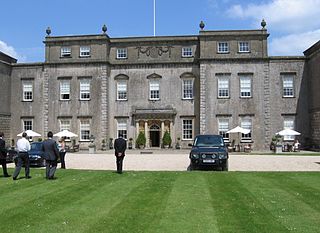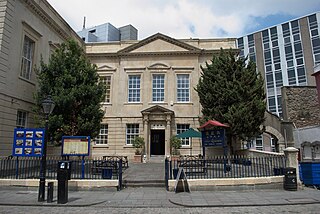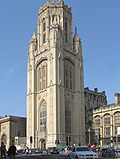
Humphry Repton was the last great English landscape designer of the eighteenth century, often regarded as the successor to Capability Brown; he also sowed the seeds of the more intricate and eclectic styles of the 19th century. His first name is often incorrectly rendered "Humphrey".

Clifton Hill House is a Grade I listed Palladian villa in the Clifton area of Bristol, England. It was the first hall of residence for women in south-west England in 1909 due to the efforts of May Staveley. It is still used as a hall of residence by the University of Bristol.

Ashton Court is a mansion house and estate to the west of Bristol in England. Although the estate lies mainly in North Somerset, it is owned by the City of Bristol. The mansion and stables are a Grade I listed building. Other structures on the estate are also listed.

Corsham Court is an English country house in a park designed by Capability Brown. It is in the town of Corsham, 3 miles (5 km) west of Chippenham, Wiltshire, and is notable for its fine art collection, based on the nucleus of paintings inherited in 1757 by Paul Methuen from his uncle, Sir Paul Methuen, the diplomat. It is currently the home of the present Baron Methuen, James Methuen-Campbell, the eighth generation of the Methuens to live there.

Prior Park is a Neo-Palladian house that was designed by John Wood, the Elder, and built in the 1730s and 1740s for Ralph Allen on a hill overlooking Bath, Somerset, England. It has been designated as a Grade I listed building.

Blaise Castle is a folly built in 1766 near Henbury in Bristol, England. The castle sits within the Blaise Castle Estate, which also includes Blaise Castle House, a Grade II* listed 18th-century mansion house. The folly castle is also Grade II* listed and ancillary buildings including the orangery and dairy also have listings. Along with Blaise Hamlet, a group of nine small cottages around a green built in 1811 for retired employees, and various subsidiary buildings, the parkland is listed Grade II* on the Register of Historic Parks and Gardens of special historic interest in England.

Bristol, the largest city in South West England, has an eclectic combination of architectural styles, ranging from the medieval to 20th century brutalism and beyond. During the mid-19th century, Bristol Byzantine, an architectural style unique to the city, was developed, and several examples have survived.

The English landscape garden, also called English landscape park or simply the English garden, is a style of "landscape" garden which emerged in England in the early 18th century, and spread across Europe, replacing the more formal, symmetrical French formal garden which had emerged in the 17th century as the principal gardening style of Europe. The English garden presented an idealized view of nature. Created and pioneered by William Kent and others, the “informal” garden style originated as a revolt against the architectural garden and drew inspiration from paintings of landscapes by Salvator Rosa, Claude Lorrain, and Nicolas Poussin.

Goldney Hall is a self-catered hall of residence in the University of Bristol. It is one of three in the Clifton area of Bristol, England.

Ston Easton Park is an English country house built in the 18th century. It lies near the village of Ston Easton, Somerset. It is a Grade I listed building and the grounds are listed Grade II on the Register of Historic Parks and Gardens.
James Bridges was an English architect and civil engineer working in Bristol between 1757 and 1763. He designed Royal Fort House (1760), rebuilt St Werburgh's Church (1758–61) and began the rebuilding of both Bristol Bridge and St Nicholas' Church.

Lathom House was a large country house in the parish of Lathom in Lancashire, England. Built between 1725 and 1740, the main block was demolished in 1925.

Park Street is a major shopping street in Bristol, England, linking the city centre to Clifton. It forms part of the A4018.

Berkeley Square is an area close to Park Street in the Clifton area of Bristol that includes buildings and a central area of greenery.

The University of Bristol Botanic Garden is a botanical garden in Bristol, England. The garden moved to its current site in Stoke Bishop in 2005, having previously been at two other sites in the city. The 4,500 species of plants are displayed in collections relating to evolution, Mediterranean, local flora and rare natives and finally useful plants.

Tyndall's Park is an area of central Bristol, England. It lies north of Park Row and Queen's Road, east of Whiteladies Road and west of St Michael's Hill, between the districts of Clifton, Cotham and Kingsdown. It includes the campus of Bristol Grammar School, and many of the buildings of the University of Bristol.

The Old Library is a historic building on the north side of King Street, Bristol, England. It was built in 1738–40 and has been designated by English Heritage as a grade II* listed building.
James Paty the Younger (1718–1779) was an English mason, builder and architect. He was a member of the Paty family which was prominent in the building of 18th century Bristol. He was the partner of his brother Thomas Paty in some of his building developments. He is also thought to have been the site architect during the rebuilding of Stoke Park House at Stoke Gifford.

Brentry Hospital was a hospital in Brentry, a northern suburb of Bristol, England. The building was constructed as a family home, one among many English country houses for the Somerset gentry. Now known as Repton Hall, after its famous architect, it has been converted into residential apartments.

Berkeley Crescent is a late 18th-century crescent of six Georgian houses with a private communal garden.






















